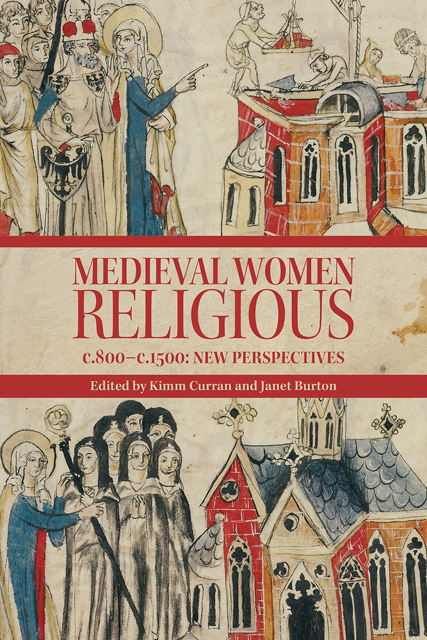Book contents
- Frontmatter
- Contents
- Illustrations
- Contributors
- Preface
- Abbreviations
- Introduction
- 1 Reform, Change, and Renewal: Women Religious in the Central Middle Ages, 800–1050
- 2 New Movements of the Twelfth Century: Diversity, Belonging, and Order(s)
- 3 Change and Renewal: Mendicants and Tertiaries in Later Medieval Europe
- 4 On the Fringes: Anchorites
- 5 ‘Quasi-religious’: Vowesses
- 6 Authority and Agency: Women as Heads of Religious Houses
- 7 Women Religious, Secular Households: The Outside World and Crossing Boundaries in the Later Middle Ages
- 8 Literacies, Learning, and Communal Reform: The Case of Alijt Bake
- 9 Family and Friends: Gift-giving, Books, and Book Inscriptions in Women’s Religious Communities
- 10 Communities of Medieval Religious Women and Their Landscapes
- 11 Materiality and Archaeology of Women Religious
- 12 Between Collective Memory and Individual Remembrance in Women’s Religious Communities
- Select Bibliography
- Index
- Miscellaneous Endmatter
9 - Family and Friends: Gift-giving, Books, and Book Inscriptions in Women’s Religious Communities
Published online by Cambridge University Press: 08 June 2023
- Frontmatter
- Contents
- Illustrations
- Contributors
- Preface
- Abbreviations
- Introduction
- 1 Reform, Change, and Renewal: Women Religious in the Central Middle Ages, 800–1050
- 2 New Movements of the Twelfth Century: Diversity, Belonging, and Order(s)
- 3 Change and Renewal: Mendicants and Tertiaries in Later Medieval Europe
- 4 On the Fringes: Anchorites
- 5 ‘Quasi-religious’: Vowesses
- 6 Authority and Agency: Women as Heads of Religious Houses
- 7 Women Religious, Secular Households: The Outside World and Crossing Boundaries in the Later Middle Ages
- 8 Literacies, Learning, and Communal Reform: The Case of Alijt Bake
- 9 Family and Friends: Gift-giving, Books, and Book Inscriptions in Women’s Religious Communities
- 10 Communities of Medieval Religious Women and Their Landscapes
- 11 Materiality and Archaeology of Women Religious
- 12 Between Collective Memory and Individual Remembrance in Women’s Religious Communities
- Select Bibliography
- Index
- Miscellaneous Endmatter
Summary
Gift-giving to women's religious communities in the form of books shows strong relationships among women religious and their patrons, each other, and families. Women religious were expected to renounce all worldly goods upon entering a monastic community; however, individuals and communities would have needed access to liturgical and sacred texts for both personal and communal devotion. The physical comfort of an inherited book can be measured in terms of emotional weight; the tactile relationship between holding a book in one's hand that had also been cradled by a loved one creates a tangible connection. Moreover, personal inscriptions in books are something that kept a vital link with the outside world and served as a constant reminder of close relationships, even in an envir¬onment that endeavoured to limit contact. This chapter examines the importance of gift giving, particularly books, in the later medieval period in England, and how patrons, benefactors, and family ensured they were remembered both by individ¬ual women religious as well as the monastic community. It further explores the importance of women and book networks, through the gift-giving of books within a religious community, with examples of inscriptions between religious women. Finally, inscriptions from family members are examined through the emotive prism of gift-giving, and the palpable connections with loved ones through the physical object of the book.
Family, Friends, and Connections
The medieval family is defined by David Herhily as a household unit, with kinship at its core (that is, relationships defined by blood or marriage). Families and wider kinship groups were significantly intertwined with women's monastic com-munities. These relationships were enhanced and solidified by patronage and ben-efaction, particularly when women entered a monastic community. Strong family links among patrons, benefactors, local communities, and women religious were to be expected as these ties – both secular and religious – were mutually beneficial. These connections were interwoven and these relationships between the outside community and the monastic house were constantly evolving. For example, every time members of the local community ‘became involved in conventual affairs like the election of a new head of house, visited a house and received hospitality, became mixed up in a conflict over rights and privileges, or later became members of the religious house or sent women as new recruits’, the relationship became more integral to the survival of both communities.
- Type
- Chapter
- Information
- Medieval Women Religious, c.800-c.1500New Perspectives, pp. 152 - 165Publisher: Boydell & BrewerPrint publication year: 2023



